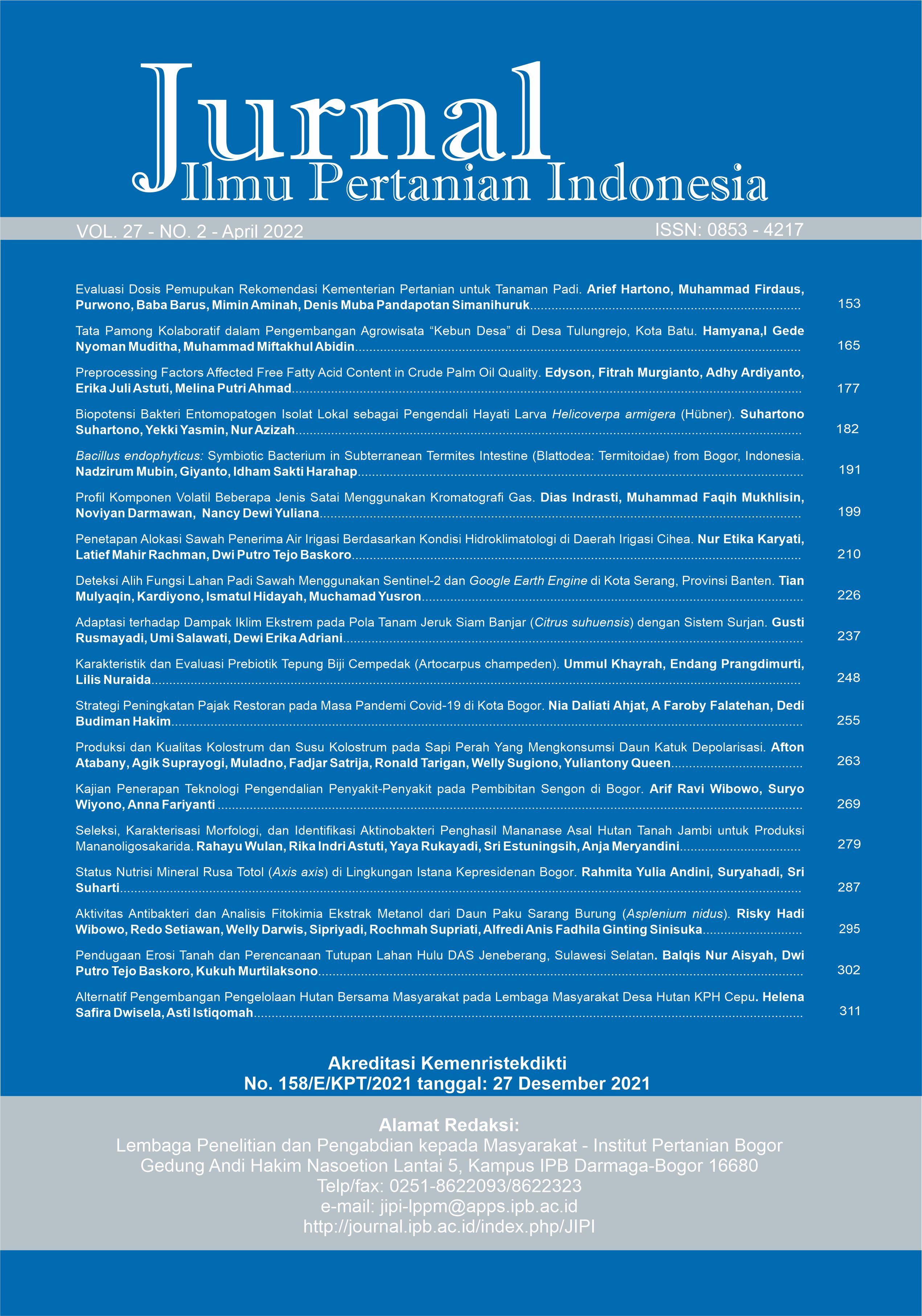Preprocessing Factors Affected Free Fatty Acid Content in Crude Palm Oil Quality
Abstract
The quality of CPO (Crude Palm Oil) is determined by the Free Fatty Acid (FFA) with the standard value below 5%. High FFA in CPO will cause further difficulties due to low refining rate and quality like rancidness and odor. The objective of this research was to determine the factors that affect the FFA content in CPO. This research was conducted from January until April 2021. Fruit samples were collected from BKLE and PNRE East Kotawaringin and analyzed to Analytical Laboratory PT BGA. The FFA value was determined using the titration method according to Indonesian National Standard (SNI). Based on this research, several factors such as rat and moth attacks, fruit maturity, fruit handling, and delayed delivery to the palm oil mill affected the FFA value. These factors caused an increase in the FFA value up to 41.10%‒204% compared to the average FFA value is only 0.77%‒1.29%. Therefore, minimizing the pre‐processing problem will reduce the potential of FFA value increment so that good quality CPO can be obtained.
Keywords: fruit handling, fruit maturity, pest attack, titration method
Downloads
References
Ali FS, Shamsudin R, Yunus R. 2014. The effect of storage time of chopped oil palm fruit bunches on the palm oil quality. Agriculture and Agricultural Science Procedia. 2: 165–172. https://doi.org/10.1016/j.aaspro.2014.11.024
Badan Standardisasi Nasional. 2006. SNI 01-2901-2006. BSN. Jakarta (ID).
Bazina N, He J. 2018. Analysis of fatty acid profiles of free fatty acids generated in deep-frying process. Jounal of Food Science and Technology. 55(8): 3085–3092. https://doi.org/10.1007/s13197-018-3232-9
Boden G. 2003. Effects of free fatty acids (FFA) on glucose metabolism: significance for insulin resistance and type 2 diabetes. Experimental and Clinical Endocrinology and Diabetes. 111(3): 121–124. https://doi.org/10.1055/s-2003-39781
Corley RHV, Law IH. 2001. Ripening, harvesting and oil extraction. The Planter. 77(906): 507–524.
Dewi LC, Susanto WH, Maligan JM. 2014. Penanganan pasca panen kelapa sawit (penyemprotan dengan natrium benzoat dan kalium sorbat terhadap mutu cpo). Journal of Food Technology. 3(2): 489–498.
Goswami G, Bora R, Rathore MS. 2015. Oxidation of cooking oils due to repeated frying and human health. International Journal of Science, Technology and Management. 4(1): 495–501.
Japir AA-WMM, Salimon J, Derawi D, Bahadi M, Yusop R. 2016. Purification of high free fatty acid crude palm oil using molecular distillation. Chemistry: An Asian Journal. 28: 2549–2554. https:// doi.org/10.14233/ajchem.2016.20095
Kementerian Pertanian. 2020. Buletin Konsumsi Pangan. Kementan.
Murphy DJ. 2014. The future of oil palm as a major global crop: opportunities and challenges. Journal of Oil Palm Research. 26(1): 1–24.
Ngando Ebongue GF, Dhouib R, Carrière F, Amvam Zollo PH, Arondel V. 2006. Assaying lipase activity from oil palm fruit (Elaeis guineensis Jacq.) mesocarp. Plant Physiology and Biochemistry. 44(10): 611–617. https://doi.org/10.1016/j.plaphy. 2006.09.006
Putri SR, Anggraini DI. 2015. Obesitas sebagai faktor resiko peningkatan kadar trigliserida. Jurnal Majority. 4(9): 78–82.
Ruswanto A, Handono Ramelan A, Praseptiangga D, Bagus Banyuro Partha I. 2020. Effects of ripening level and processing delay on the characteristics of oil palm fruit bunches. International Journal on Advanced Science Engineering and Information Technology. 10(1): 389. https://doi.org/ 10.18517/ijaseit.10.1.10987
Saad B, Ling CW, Jab MS, Lim BP, Ali ASM, Wai WT, Saleh MI. 2007. Determination of free fatty acids in palm oil samples using non-aqueous flow injection titrimetric method. Food Chemistry 102(4): 1407–1414. https://doi.org/10.1016/j.foodchem. 2006.05.051
Sharif ZBM, Taib NBM, Yusof MSB, Rahim MZB, Tobi ALBM, Othman MSB. 2017. Study on handling process and quality degradation of oil palm fresh fruit bunches (ffb). IOP Conference Series: Materials Science and Engineering. 203. https://doi.org/10.1088/1757-899X/203/1/012027
Sambanthamurthi R, Sundram K, Tan Y. 2000. Chemistry and biochemistry of palm oil. Progress in Lipid Research 39(6): 507–558. https:// doi.org/10.1016/S0163-7827(00)00015-1
Sudibyo A, Lestari N. 2015. Kajian keamanan pangan senyawa ester 3-MCPD dalam produk minyak/lemak pangan dan produk pangan lainnya. Warta Industri Hasil Pertanian. 32(01): 16–23.
Tan C-H, Ghazali HM, Kuntom A, Tan C-P, Ariffin AA. 2009. Extraction and physicochemical properties of low free fatty acid crude palm oil. Food Chemistry. 113(2): 645–650. https://doi.org/10.1016/ j.foodchem.2008.07.052
Ulfah M, Riswanto A, Ngatirah N. 2016. Characteristics of oil blends from red palm oil and palm kernel olein. Agritech. 36(02): 145. https://doi.org/ 10.22146/agritech.12858
This journal is published under the terms of the Creative Commons Attribution-NonCommercial 4.0 International License. Authors who publish with this journal agree to the following terms: Authors retain copyright and grant the journal right of first publication with the work simultaneously licensed under a Creative Commons Attribution-NonCommercial 4.0 International License. Attribution — You must give appropriate credit, provide a link to the license, and indicate if changes were made. You may do so in any reasonable manner, but not in any way that suggests the licensor endorses you or your use. NonCommercial — You may not use the material for commercial purposes.






















